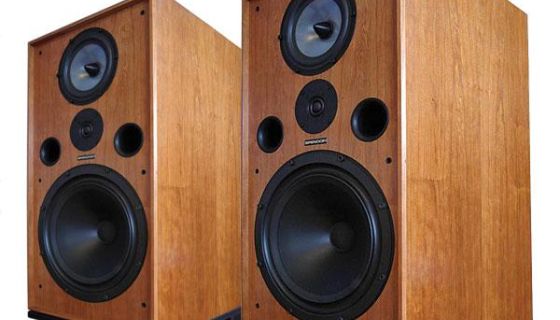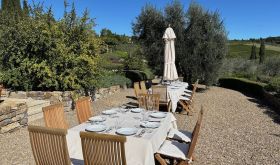Wine commentary loves to reference music. It’s as if those who are obsessed with the former are genetically destined to obsess about the latter. Single varietal wines are soloists while blends are concertos. Volume of alcohol is literalised into pianissimo and fortissimo. This wine is baroque while that one is heavy metal.
I wonder if music writers ever compare their art form to wine? The nocturne was played with all the haunting beauty of a Vosne-Romanée Malconsorts. The extended free jazz passage was as tasteless as Trebbiano. The drummer had the muscle of Tannat but the soul of Nebbiolo. I somehow doubt it.
However, there is one particular parallel between music and wine that remains under-explored. It involves more tangible, less romanticised factors, yet it is an integral part of the experience of music and wine. For music requires a means for its broadcast, while wine is dependent on a vessel to drink it from. The analogy between stereos and stemware is strong if rarely considered. [I must say that I have never felt a stronger parallel with a professional in another field than when listening to the sales pitch of the guy who sold us our hifi – JR]
Audio Lounge on Wigmore Street in London is a retailer of the most highly engineered, exclusive audio brands you’ve never heard of at unheard-of prices. For example, a Crystal Cable Absolute Dream mains power lead for a CD player costs £7,000. Let me repeat that: seven thousand pounds for a power cable. (If that shocked you, remember that you've just experienced what most people feel when they hear of wines costing many times more than even that.)
Amplifiers that look like nuclear reactors. Valves glowing warm with voltage. Silent, silver boxes boasting a single mysterious button. The most desirable, refined, cutting edge technology. In their basement they have a listening room where this hardware is set up to demonstrate the impact equipment can have on music. It seemed like a good location in which to gather two wines, four different glasses plus some favourite CDs to investigate just how much exquisite sensorial pleasure a person can stand in one sitting.
Never was a guinea-pig more willing.
Arif Huseyin was our host at Audio Lounge, a man fizzing with enthusiasm for this technology. Fanaticism gets lots of bad press these days, but when it’s applied to the pursuit of a worthy passion, it generates commitment that can only be admired. For it is this sort of devotion that drives improvement for us all – not just at the top level, but every level.
Down we sat, then, wearing our most serious and contemplative frowns, as one does when trying to bridle excitement. The first system we listened to was contemporary, as follows:
Bel Canto CD3t CD transport @ £1,349
Devialet D240 system streaming solution @ £11,800
Vivid Audio V1.5 loudspeakers @ £6,250
Siltech cables @ £2,700

Whereas the second was more traditional:
Bel Canto VBS power supply @ £1,299
Bel Canto CD3t CD transport @ £1,349
Bel Canto DAC3.5VBmkII digital to analogue convertor @ £3,199
Pathos S9 integrated valve amplifier @ £6,750
Spendor Audio SP100R2 loudspeakers @ £6,995
Siltech Cables @ £5,300

The difference between the two was subtle yet profound. Like wine, sensorial experience defies adequate description. On listening to the first system, I wrote that the low register of the piano had an uncanny clarity. There was no muddiness: every note was bright and clear. There was a tremendous purity, too. All these adjectives can apply equally to wine – young trocken Riesling, perhaps, or Hawke’s Bay Syrah.
The second, valve-based system was warmer and softer. There was a sort of roundness to the tone, I noted – a description that makes no semantic sense, really. Arif described valves as adding ‘colouration’ – again, abstruse out of context, but hearing was believing.
Deciding between the two was less about intrinsic quality than it was instinctive feeling. We shared a consensus that the valve system had more appeal to us than its solid state counterpart. This felt like a predictable, conservative choice – a victory for Bordeaux and Burgundy over Margaret River and Sonoma.
This was only half the decision to make, however, because we were also testing glassware in the shape of Zalto's Universal and Burgundy glasses, versus Schott Zweisel's Cru Classic White and Burgundy kindly provided by Daniel Primack of Around Wine, the wine accessories store nearby.

This was more familiar ground for me, and the Zalto had a clear advantage, giving a much more open and expressive nose, whereas the Schott Zweisel seemed more muted. In appearance, the thin, angular Zalto is the modernist of the two, while the classic curves of the Schott Zweisel are more representative of a traditional glass.
The comparisons are irresistible: Zalto was modern engineering providing clarity and precision whereas Schott Zweisel gave a softer impression. Yet our preference veered towards the Zalto in this case, because it illuminated more of the wine, providing more flavour and concentration to enjoy.
There is something intrinsic to human nature that demands the best. We want the best wines, the best glasses, the best amplifier. Yet this is applying an absolute judgement to an analogue scale. Arif talked of the different systems for different rooms – even for different types of music. There was no way of saying that a £25,000 system was ten times better than one costing £2,500, he said – but that there will be a sweet spot for each individual.
The closer we looked, the more apposite the comparison with wine and wine glasses seemed to become. But there was one last parallel to be drawn. As we progressively listened to each track on the different systems, the volume grew. Enjoying the novelty and rarity of the experience, Daniel and I, amateurs of such equipment, called for it to be louder and louder. We wanted more volume, more power, more intensity. Then, as we were preparing to leave, Arif began to turn the volume down. Listen to that, he told us. You could still hear all the nuances and tones and dynamics as it got quieter and quieter, and when it finally became silent, somehow you could hear it still.
Audio Lounge, 138 Wigmore Street, London W1U 3SG
Around Wine, 57 Chiltern Street, London W1U 6ND
We listened to:
Michael Praytor, Five Years Later by Ben Folds Five, from The Sound Of The Life Of The Mind (2012, ImaVeePee)
(Nice Dream) by Radiohead, from The Bends (1995, Parlophone)
We tasted:
Ch d'Esclans, Garrus rosé 2011 Côtes de Provence
Escarpment, Kiwa Pinot Noir 2009 Martinborough














